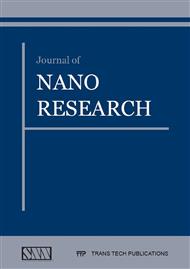[1]
P.R. Chawla, I.B. Bajaj, S.A. Survase, R.S. Singhal, Microbial Cellulose: Fermentative Production and Applications, Food Technol. Biotech. 47 (2) (2009) 107-124.
Google Scholar
[2]
W. Czaja, A. Krystynowicz, S. Bielecki, M. Brown Jr., Microbial cellulose – the natural, Biomaterials 27 (2) (2006) 145-151.
DOI: 10.1016/j.biomaterials.2005.07.035
Google Scholar
[3]
W. Czaja, D. Romanovicz, M. Brown Jr., Structural investigations of microbial cellulose produced in stationary and agitated culture, Cellulose 11 (2004) 403-411.
DOI: 10.1023/b:cell.0000046412.11983.61
Google Scholar
[4]
W.A. Daoud, J.H. Xin, I. Zhang, Surface functionalization of cellulose fibers with titanium dioxide nanoparticles and their combined bactericidal activities, Surf. Sci. 599 (2005) 69-75.
DOI: 10.1016/j.susc.2005.09.038
Google Scholar
[5]
F. Esa, M.S. Tasirin, A.N. Rahman, Overview of Bacterial Cellulose Production and Application, Agric. Agric. Sci. Procedia 2 (2014) 113-119.
DOI: 10.1016/j.aaspro.2014.11.017
Google Scholar
[6]
O.L. Galkina, A. Sycheva, A. Blagodatskiy, G. Kaptay, V.L. Katanaev, G. Seisenabeva, The sol–gel synthesis of cotton/TiO2 composites and their antibacterial properties, Surf. Coat. Tech. 253 (2014) 171-179.
DOI: 10.1016/j.surfcoat.2014.05.033
Google Scholar
[7]
J. Gutierrez, A. Tercjak, I. Algar, A. Retegi, I. Mondragon, Conductive properties of TiO2/bacterial cellulose hybrid fibres, J. Colloid Interf. Sci. 377 (2012) 88-93.
DOI: 10.1016/j.jcis.2012.03.075
Google Scholar
[8]
W. Hu, S. Chen, J. Yang, Z. Li, H. Wang, Functionalized bacterial cellulose derivatives and nanocomposites, Carbohyd. Polym. 101 (2014) 1043-1060.
DOI: 10.1016/j.carbpol.2013.09.102
Google Scholar
[9]
Y. Hu, J.M. Catchmark, Formation and Characterization of Spherelike Bacterial Cellulose Particles Produced by Acetobacter xylinum JCM 9730 Strain, Biomacromolecules 11 (2010) 1727-1734.
DOI: 10.1021/bm100060v
Google Scholar
[10]
S. Kalia, A. Dufresne, B.M. Cherian, B.S. Kaith, L. Averous, Cellulose-Based Bio- and Nanocomposites: A Review, Int. J. Polym. Sci. (2011) 837-875.
Google Scholar
[11]
S. Khan, M. Ul-islam, W.A. Khattak, M.W. Ullah, J.K. Park, Bacterial cellulose-titanium dioxide nanocomposites: nanostructural characteristics, antibacterial mechanism, and biocompatibility, Cellulose 22 (2015) 565-579.
DOI: 10.1007/s10570-014-0528-4
Google Scholar
[12]
D. Klemm, B. Heublein, H. Fink, A. Bohn, Cellulose: Fascinating Biopolymer and Sustainable Raw Material, Angew Chem-Ger. Edit. 44 (2005) 3358-3393.
DOI: 10.1002/anie.200460587
Google Scholar
[13]
P.A.A.P. Marques, T. Trindade, C. Pascoal Neto, Titanium dioxide/cellulose nanocomposites prepared by a controlled hydrolysis method, Compos. Sci. Technol. 66 (2006) 1038-1044.
DOI: 10.1016/j.compscitech.2005.07.029
Google Scholar
[14]
J.R. Moon, A. Martini, J. Nairn, J. Simonsen, J. Youngblood, Cellulose nanomaterials review: structure, properties and nanocomposites, Chem. Soc. Rev. 40 (2011) 3941-3994.
DOI: 10.1039/c0cs00108b
Google Scholar
[15]
W. Zhou, Z. Li, Z. Zhang, K. Onda, S. Ogihara, Y. Okimoto, S. Koshihara, Nanostructured TiO2 photocatalyst and pump-probe spectroscopic study, Front. Mater. Sci. 3 (4) (2009) 403-408.
DOI: 10.1007/s11706-009-0055-7
Google Scholar
[16]
H. Zhou, X. Chen, Characteristics and degradation of chitosan/cellulose acetate microspheres with different model drugs, Front. Mater. Sci. 2 (4) (2008) 417-425.
DOI: 10.1007/s11706-008-0063-z
Google Scholar
[17]
P. Ross, R. Mayer, M. Benziman, Cellulose Biosynthesis and Function in Bacteria, Microbiol. Rev. 55 (1) (1991) 35-58.
DOI: 10.1128/mr.55.1.35-58.1991
Google Scholar
[18]
I. Sulaeva, U. Henniges, T. Rosenau, A. Potthast, Bacterial cellulose as a material for wound treatment: Properties and modifications. A review, Biotechnol. Adv. 33 (2015) 1547-1571.
DOI: 10.1016/j.biotechadv.2015.07.009
Google Scholar
[19]
M.J. Uddin, F. Cesano, F. Bonino, F. Bordiga, G. Spoto, D. Scarano, A. Zecchina, Photoactive TiO2 films on cellulose fibres: synthesis and characterization, J. Photoch. Photobio. A 189 (2007) 286-294.
DOI: 10.1016/j.jphotochem.2007.02.015
Google Scholar
[20]
S. Yeh, Y. Chen, C. His, H. Ko, M. Wang, Thermal Behavior and Phase Transformation of TiO2 Nanocrystallites Prepared by a Coprecipitation Route, Metall. Mater. Trans. A 45 (1) (2014) 261-268.
DOI: 10.1007/s11661-013-1963-9
Google Scholar
[21]
H. Zhu, J. Shiru, T. Wan, Y. Jia, H. Yang, J. Li, L. Yan, C. Zhong, Biosynthesis of spherical Fe3O4/bacterial cellulose nanocomposites as adsorbents for heavy metal ions, Carbohyd. Polym. 86 (2011) 1558-1564.
DOI: 10.1016/j.carbpol.2011.06.061
Google Scholar
[22]
S.Y. Oh, D.I. Yoo, Y. Shinb, G. Seo, FTIR analysis of cellulose treated with sodium hydroxide and carbon dioxide, Carbohyd. Res. 340 (2005) 417-428.
DOI: 10.1016/j.carres.2004.11.027
Google Scholar
[23]
M.A. Mohamed, W.M.N. Salleh, J. Jaafar, A.F. Ismail, M.B. Mutalib, S.M. Jamil, Incorporation of N-doped TiO2 nanorods in regenerated cellulose thin films fabricated from recycled newspaper as a green portable photocatalyst, Carbohyd. Polym. 133 (2005).
DOI: 10.1016/j.carbpol.2015.07.057
Google Scholar
[24]
D. Sun, J. Yang, X. Wang, Bacterial cellulose/TiO2 hybrid nanofibers prepared by the surface hydrolysis method with molecular precision, Nanoscale 2 (2010) 287-292.
DOI: 10.1039/b9nr00158a
Google Scholar


